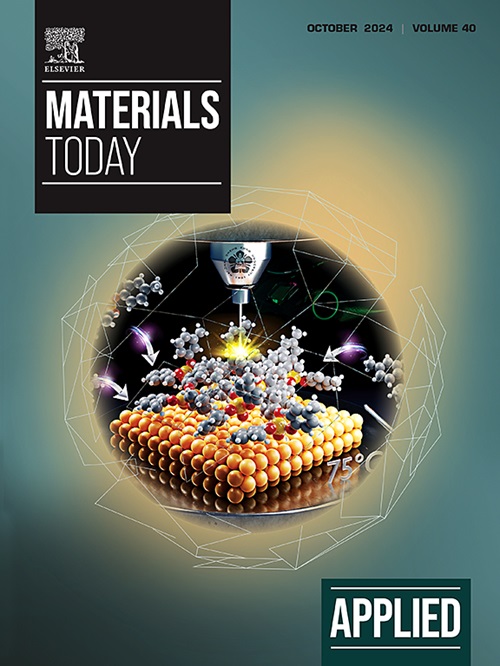三维打印的多色普鲁士蓝-紫胶混合电致变色装置:实现高对比度和快速切换的电致变色器件
IF 6.9
2区 材料科学
Q1 MATERIALS SCIENCE, MULTIDISCIPLINARY
引用次数: 0
摘要
利用数字光处理技术,成功开发出一种新型三维打印多色普鲁士蓝-紫胶无机-有机杂化电致变色装置。光固化的 1-(2-氰基苯基)-1′-(2-羟乙基)-[4,4′-联吡啶]-1,1′-二鎓(CPHEV)离子凝胶被打印在 ITO 玻璃上作为电致变色层。普鲁士蓝(PB)薄膜作为离子存储层被电沉积在另一块 ITO 玻璃上。有了普鲁士蓝薄膜,ECD 的漂白时间比没有普鲁士蓝薄膜的 ECD 快 330 倍。此外,ECD 还在 L*a*b* 色彩空间中表现出多重着色,漂白态和着色态之间的最高不同色点(ΔE*)值为 75.2。在 296 cm C 时,ECD 的着色效率很高,相当于 -2.5 V 时全光开关的 60%。利用数字光处理(DLP)技术成功展示了三维打印的 ECD,具有很高的尺寸精度和分辨率。本文章由计算机程序翻译,如有差异,请以英文原文为准。
3D printed multicolor Prussian blue-viologen hybrid electrochromic devices: Toward high contrast ratio and fast switching electrochromic devices
A new 3D printed multicolor Prussian blue-viologen inorganic-organic hybrid electrochromic device was successfully developed using digital light processing. Photocurable 1-(2 cyanophenyl)-1′-(2-hydroxyethyl)-[4,4′-bipyridine]-1,1′-diium (CPHEV)-based ionogel was printed on ITO glass as an electrochromic layer. The thin film of Prussian blue (PB) was electrodeposited on another ITO glass as an ion storage layer. With PB thin film, the ECDs exhibited a bleaching time 330 times faster than that of ECDs without PB. The ECD showed excellent electrochromic performance with a high color contrast ratio of 93.4 % at -2.5 V with a pulse width of 5 s. Moreover, the ECDs also exhibited multi-coloration in L*a*b* color space with the highest different color points (ΔE*) value of 75.2 between the bleaching state and coloring state. A high coloration efficiency of the ECD was obtained at 296 cm C corresponding to 60 % of a full optical switch at -2.5 V. The 3D printed ECD was successfully demonstrated using digital light processing (DLP) with high dimensional accuracy and resolution.
求助全文
通过发布文献求助,成功后即可免费获取论文全文。
去求助
来源期刊

Applied Materials Today
Materials Science-General Materials Science
CiteScore
14.90
自引率
3.60%
发文量
393
审稿时长
26 days
期刊介绍:
Journal Name: Applied Materials Today
Focus:
Multi-disciplinary, rapid-publication journal
Focused on cutting-edge applications of novel materials
Overview:
New materials discoveries have led to exciting fundamental breakthroughs.
Materials research is now moving towards the translation of these scientific properties and principles.
 求助内容:
求助内容: 应助结果提醒方式:
应助结果提醒方式:


